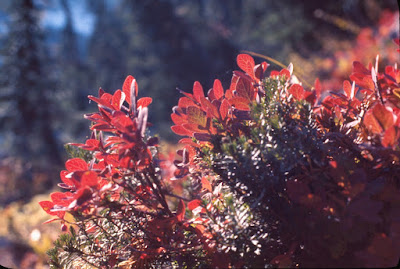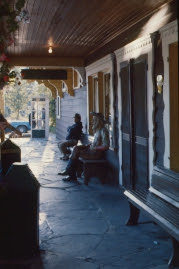For some unknown reason, Kem and I decided to climb Mt. Challenger in the North Cascades. It looked easy enough and the Becky book didn't deter us. We sure didn't think it through well enough. Youth. Climbing in North Cascades in June? We didn't have the skill, expertise, and gear for such adventure.
We connected with Denny back in Issaquah for his canoe and soon after we drove the old "Woodstocker" pickup that Dana and I used for our summer fire wood business down to Issaquah. One end of the canoe stuck out and over the cab and the other end stuck out the bed of the truck. It must have been unnerving for drivers behind us.
Our first day consist of having Sharon drive us to Colonial Campground. From there we paddled on Diablo Lake the short distance to Ross Dam. Workers at the dam used their truck to haul us around the dam.
We had the canoe packed and on the water when we realized we had no experience canoeing. Kem didn't seem too concerned. Kem recalls, "In the canoe we had no life jackets.....although the canoe was supposedly "sink-proof," clinging to an overturned canoe, or trying to swim for it in an icy, glacier fed mountain lake is dubious at best. Generally we were smart enough to hug the shore, just for that reason, but we did cross the middle of the lake to get to the East shore where we caught the fish, and cruised up the stream as far as we could go."
That is the bridge that carries Highway 20 over Diabo Lake which is below Ross Dam.
The road we used to haul our gear to the lake took
us through a tunnel.
Looking south from the trail we could see Colonial Peak.
We had calm winds on Ross Lake as we made our way to the trail head at Big Beaver where we spent our first night. That is Big Beaver Creek dropping into a low-level Ross Lake.
Kem introducing a deer to his cooking. If he had listened to me we would have had venison for dinner instead of that can of chile on the table. Kem recalls: "The deer in the photo was quite bold. I was unpacking our food on the picnic bench when she strolled into camp. Part of our food stock was a large, unsliced loaf of French bread, which was sticking out of the pack. The doe walked up right next to me and grabbed the end of the loaf in her teeth. I spun and grabbed the other end. A tug of war ensued. I "won" in that I came away with the larger piece, approximately two-thirds of the loaf. The doe retreated with her piece."
Our campsite at the trail head.
We secured the canoe away from the campsite for safe keeping. What was the rational for securing it to a tree standing up? Kem recalls, "We were concerned that animals would ravage our food supply while we were off on the climbing part of the trip. We put our extra food stocks in a bag, and tied it to one of seats in the canoe...then hoisted the canoe upright. This put the food eight feet off the ground, plus gave it some weather protection. When we returned everything was as we had left it, except for one full-sized Snickers bar that had been chewed at one end....probably by a rather acrobatic chipmunk. I really wanted that bar, so I sliced off the chewed end with a pocket knife, and ate the rest."
All packed up and ready to conquer Mt. Challenger.
The Big Beaver trail followed the Big Beaver stream. Once through the Douglas-fir stand, we entered the first grove of western red cedar which looked to be about eight feet in diameter. At about three miles was another grove of cedars that seemed to big larger. At five and a half miles we crossed the Thirty-nine Mile Creek which has a shelter for backpackers. It was an easy hike.
Kem leading out on the Big Beaver trail.
We spent the day making our way up Beaver Creek trail to the shelter. We were using the Mountaineers' guidebook "Routes and Rocks in the Mt. Challenger Quadrangle". It is in my left back pocket in the photograph below. My notes indicate that "Between 300 yards and a 1/4 miles north of the Beaver Pass shelter" we headed west. The guidebook describes it as "[Leave the trail] just south of Beaver Pass and immediately south of two brush slashes coming down to the pass from the west. Climb straight up through brushy woods to the timberline; this is the only unpleasant going". It was tough. Really tough going. The Stones' lyrics "No, you can't always get what you want. But if you try sometime you You get what you need" was stuck in my head as we fought our way up the slope. What a way to pass the day. We finally gained an easy slope south of the crest. Once there we could see the Picketts. We determined then that we could never ascend Challenger safely that day. Nor any day until we gained more experience and proper equipment. We used the clouds coming in over the Picketts as our excuse to abandon our climb.
Mt. Challenger is right of center.
We rested before heading down the snowfield and back into the brush and to Big Beaver trail and the shelter. Kem recalls, "By today's standards, our trip is a text book example of how not to do it. Note the photographs....we are wearing a cotton top and bottom all the time. We wore cotton jeans to mountain climb in. We had no rope, no crampons, no map (that I recall), no extra gear for any emergency....I'm not sure anyone even knew where we were."
We look like we had just received our grades for the spring quarter. Note the rope at my foot.
Kem glissades down the snowfield.
That is Big Beaver valley ahead of us. We had a long way to go.
We spent the night in this hiker's cabin. Bored, I looked for something to do.
Kem remembers, "You probably neglected to mention the book I found in that old shelter. I would read it by flashlight at night. It was a mystery "whodunnit"...as I reached the end of the book I discovered that you had removed the last three pages and used them to start the campfire.....never did find out who done it."
Once back to the lake, I used the cold water to clean up and cool off.
We hung our high-tech lightweight packs away from the critters.
We used the day to rest. Doing so gave us time to discuss plan B.
The next day we headed up the lake to Lighting Creek. We were lucky there was no wind on the lake.
Ross Lake is known for its afternoon winds.
I don't remember how long it took us to get to Lighting Creek. Once we saw the opening we turned into it and paddled all the way to a waterfall. We turned the canoe around and Kem took a photo of me as if we had just paddled the falls. I lost that photo.
My guess is those are fish Kem caught. "Here bear, here bear."
Kem remembers, "I caught the trout we ate with a flatfish lure trailed out behind the canoe on a hand line. We got two nice big ones, each about 17 inches each. The fish were caught off the mouth of a stream, right next to a buoy with a "no fishing" sign....the stream mouths were off limits because the fish congregated there and that made them easy to catch, as proved by our success. We pan fried those two fish and ate the meat. Not sure what we did with the heads, bones and skins, but the scent of fish cooking should have brought every bear within eight miles....can't believe we didn't get raided that night."
The next day we paddled back to Ross Dam in a wind storm. Once we arrived at the dam we helped ourselves to hauling our gear and canoe around the dam. There was no crew or truck. When we finished our paddle to Colonial Campground, Kem decided to hitchhike back to Bellingham for the truck. He recalls, "I don't recall a coin toss. I think I was just more ready to get back to real food and a soft bed than you were.....my hitch hike trip was an adventure from hell, all on its own...I got picked up by a crazy bastard from the South driving a super stock Dodge, just like the little ole lady from Pasadena...he had his 17 year old girlfriend in the front seat, a confederate flag on the bumper...his mother was in back, with me...we headed down that winding road, never under 75 miles per hour, drifting through the corners, then roaring down the straight stretches at near 100...I kept looking at his mom, my eyes practically begging her to say something, but she just smiled back like 'never you worry'.... When they reached the junction with I-5, I asked him if they were headed North, or South. He said, 'North....' 'Aw geez,' I said, 'I'm headed South,' and got out.... As soon as they were out of sight I hitched a ride, North, with a tug boat skipper who gave me a ride all the way to our house."
My version is that we called Sharon and she picked us up at Colonial a few hours later. There must have been a phone at the campground. I remember her disappointment on the phone that we were coming home early. Kem and I spent hours on the beach waiting for our pickup and discussing that. Oh, well.
Overall, we chalked it up as a learning experience. It was a long time before we tried another climb.
Kem sums it up nicely: "On the bright side we had plenty of food, and I don't recall being cold. Any trip that you survive is a good trip, and it certainly was an ambitious adventure."


























































































































